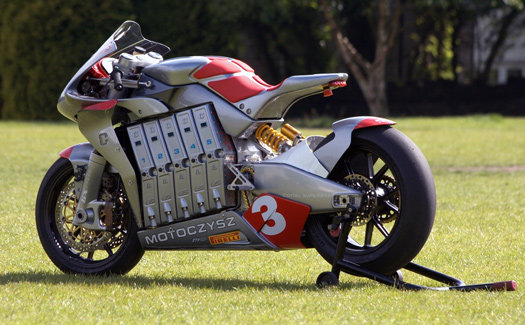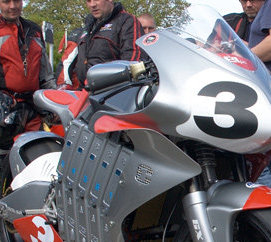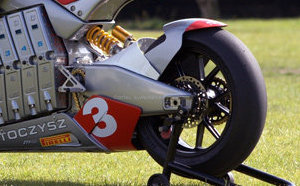There’s More Than Magic Smoke Swirling In The 2010 MotoCzysz e1pc
We have all have heard about and seen the power of the 2010 e1pc. Last week the pictures and this week the proof on the track of the amazing 131.1 mph through the Sulby speed trap. The MotoCzysz e1pc has again won the motorcycle enthusiasts’ hearts with brute force power and elegant design.
Yesterday, Wes Siler of HFL fame took an exclusive dive into the tech behind the 2010 e1pc on Popular Science. Yes, the power is amazing. Almost 500 volts from 12.5 kWh packs feed an oil cooled brushless internal permanent magnet DC motor smaller than an Agni 95 that has more continuous power than 3 95’s combined. 75 kW of continuous power equates to 250 ft-lbs of torque and 100 hp programmable to come on whenever Czysz feels it should. MotoCzysz’s rider, Mark Miller, averaged less than 40% throttle during the race, says Siler. No question this is all amazing engineering and performance.
OK, forget all that tire roasting power. One of the coolest things Wes reported on is the aerodynamics built into the e1pc. I think the question of whether MC will streamline has been answered. They don’t need to. The Czysz team engineered into the bike a new way to skin the power robbing cat that is wind resistance.
When a motorcycle and rider cut through the wind they are followed by a pocket of negative pressure as the air tries to fill the void behind them. Streamlining guru Craig Vetter lessens the drag this negative pressure causes with a wing-like tail section that directs air flow on each side of the bike gradually back together after the front of the bike splits it. It seems the e1pc creates this tail section virtually with the wind that passes through the bike and out under the seat. Two wings in front of the riders knees direct the air into the ducts in the frame.
Kawasaki started capturing high speed airflow on the ZX series decades ago to force it into the airbox and increase engine horsepower. Seems cheating the wind might have been a better use of that frontal pressure. The e1pc rider can also move back on the small tail section to help facilitate a wing-like shape perfected by Vetter. The large swingarm, hugger and plastic number plate help reduce drag around the rear wheel and build a more perfect “wing”. At least that is how I understand it. No doubt we will get more information from aerodynamics experts on how it works very soon.
With that considered, Team Agni may have the only dustbin fairing in the 2010 TT Zero but they are not the only team serious about aerodynamics. Check out Wes’s story (linked below) on Popular Science and tune into the 2010 TT Zero today at 11 AM Eastern to see who takes second, third and fourth. Barring any technical issues, Mark Miller on the MotoCzysz e1pc seems to be a clear favorite to win.
Source: Wes Siler on Pop Sci Photos: Amadeus Photography (via source)
In: MotoCzysz, TT Zero · Tagged with: 2010 MotoCzysz e1pc, areodynamics, dustbin, E1pc, eDD, fairings, magic smoke, Michael Czysz, MotoCzysz, streamlining, Suitcase, Technical, technology, wind resistance




on June 10, 2010 at 10:00 am